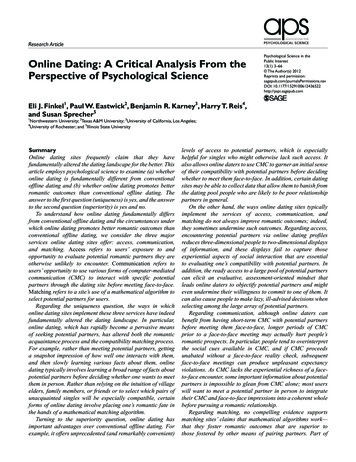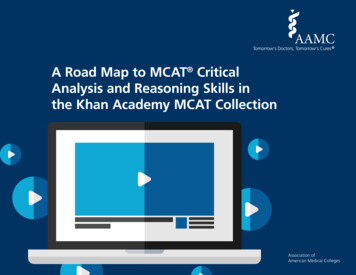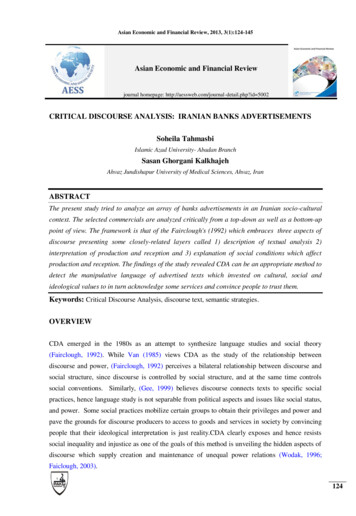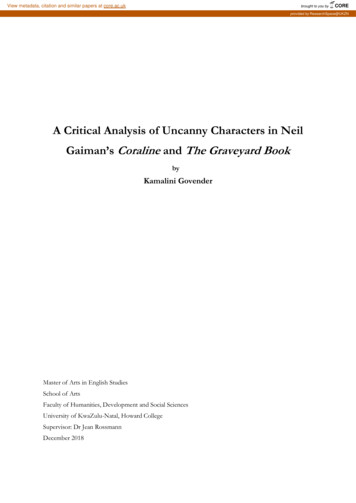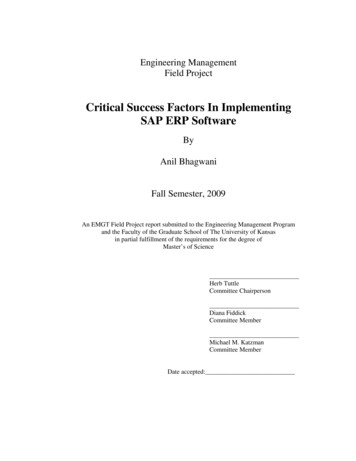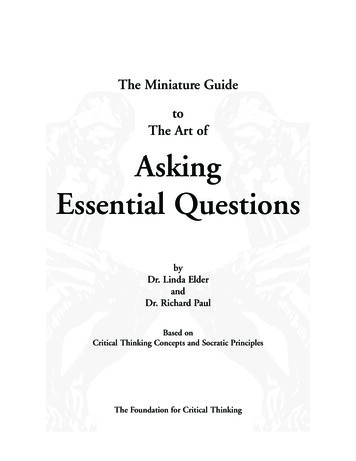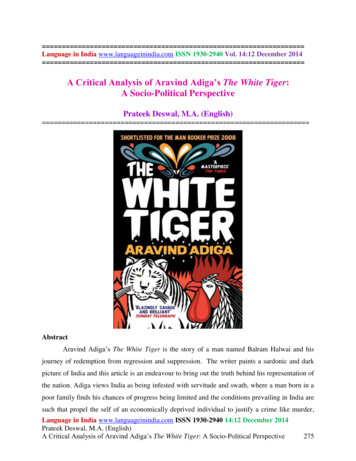
Transcription
Language in India www.languageinindia.com ISSN 1930-2940 Vol. 14:12 December 2014 A Critical Analysis of Aravind Adiga’s The White Tiger:A Socio-Political PerspectivePrateek Deswal, M.A. (English) AbstractAravind Adiga’s The White Tiger is the story of a man named Balram Halwai and hisjourney of redemption from regression and suppression. The writer paints a sardonic and darkpicture of India and this article is an endeavour to bring out the truth behind his representation ofthe nation. Adiga views India as being infested with servitude and swath, where a man born in apoor family finds his chances of progress being limited and the conditions prevailing in India aresuch that propel the self of an economically deprived individual to justify a crime like murder,Language in India www.languageinindia.com ISSN 1930-2940 14:12 December 2014Prateek Deswal, M.A. (English)A Critical Analysis of Aravind Adiga’s The White Tiger: A Socio-Political Perspective275
and become a legal as well as social criminal. Adiga has raised many issues in his work and it isa fact beyond contestation that India is being confronted by most of the issues put forth by him.But what concludes his work as an unacceptable representation of India is that he has increasedthe magnitude of the problems manifold, so that they seem to be the dominant factor in Indiansociety. It cannot be argued that his work is devoid of reality, but it is indeed the exaggeration ofreality, which makes his work liable to criticism and splenetic reactions. My paper wouldcritically examine and bring about clarity between Adiga’s India and the real India.Key words: Aravind Adiga, White Tiger, Light, Darkness, Servitude, Defunct.Indian Diversity and Indian Writing in EnglishThe worst of times usually brings about the best in nations. And India throughout itsglorious history, has encountered its fair share of adversities, whether they be in the form ofinvasions, slavery or famines and so on. Each part of history is unique, in its own way and theconsciousness of the nation has always found an effective medium to express itself through thewriters of the age. Same is the case with modern-day India in which the Chetan Bhagats, VikramSeths, Amitav Ghoshs have become the voice of the nation. However, the new age writers ofIndia will probably find the task more difficult than their predecessors, primarily because ofIndia’s diversity and divisions existing in its social, economic and cultural areas. India one of themost diverse nations in the world is almost incomprehensible and cannot be limited within therealms of a single book. Its facets are just too many, to be amalgamated into one single work.That is why Chetan Bhagat has more or less focused on college students’ life, mainly that ofengineering students in his novels. In the same manner, a far too dangerous endeavour wasundertaken by Aravind Adiga in his work “The White Tiger”, that was to become the voice ofthe poor, downtrodden, the colossal underclass of the world’s biggest democracy.White Tiger – A Riveting Tale of the Realistic Anti-heroAravind Adiga, an Indian born, Australian educated writer, shot to fame with his veryfirst work “The White Tiger”, which went on to win the Man Booker prize in 2008, defeatingstiff competition from the likes of Salman Rushdie. Mr.Portillo the chairman of Booker prizepanel 2008 stated that he was looking for something that would “blow his socks off” and singledLanguage in India www.languageinindia.com ISSN 1930-2940 14:12 December 2014Prateek Deswal, M.A. (English)A Critical Analysis of Aravind Adiga’s The White Tiger: A Socio-Political Perspective276
out THE WHITE TIGER by Aravind Adiga. The writer presents a riveting tale of the realisticanti-hero Balram Halwai, who although born in the most humble surrounding, harbours amarlowesque ambition to rise above his predetermined fate to be born and die in “the darkness”and achieves it through his ruthless planning of the murder of his master Ashok.An Epistolary NovelThrough this epistolary novel written in a series of seven letters over seven nights,addressed to the Chinese Premier Wen Jiaboa, the writer paints a cynical, supercilious andunromanticized picture of India where education system is defunct, elections are rigged, povertyis rampant, almost ubiquitous and the poor have to face appalling regression at the hands of theelites as the writer divides the nation in two distinct zones –“India is two countries in one: an India of light and an India of darkness. Theocean brings light to my country. But [the Ganges] river brings darkness to India the black river”. (14, The White Tiger)The western world took the novel to be a mirror of India. However the Indian audiencedecried it due to the bleak depiction of Indian society. Amardeep Singh dismissed it asfundamentally fake and freelance editor Anjali Kapoor declared“Adiga is the same [as Naipaul] focusing on everything that is bad and corrupt” (The Telegraph,Oct. 18 2008)Two Contrasting Visions of India – Mirror of India versus Bleak Description of IndiaExistence of these two contrasting versions is primarily due to the fact that India as aconcept has always intrigued the west. Some consider it to be the library of ancient knowledge asdepicted in Robin Sharma’s The Monk Who Sold His Ferrari, while others consider it asfloundering in poverty, hunger, naked bodies and hungry bellies. Some believe it to be thestorehouse of intellectual knowledge while others can only view Adiga’s “glistening lines ofsewage”. But among these one thing is pretty certain- India will always continue to be anintricate puzzle for the west because it is probably none of these and even more possibly both ofLanguage in India www.languageinindia.com ISSN 1930-2940 14:12 December 2014Prateek Deswal, M.A. (English)A Critical Analysis of Aravind Adiga’s The White Tiger: A Socio-Political Perspective277
them. This in fact is a matter which needs its own deep and detailed exposition. However, thequestion here is how realistic is Adiga’s representation of India.“I am Tomorrow”In the very initial stage of the story Balram Halwai declares - “I am tomorrow “(4). Herehe represents not just himself but Adiga’s “colossal underclass”. He is the rickshaw puller,coolie, beggar, worker, and each one in India who has a small belly as the writer propounds thatit is a country with only two castes –“Men with big bellies and men with small bellies”. (64, The White Tiger)But here we are listening to the voice of an exception that belongs to none of these, butexperiences both. However, as we go further our omniscient narrator ceases to remain theimpartial executioner of Indian society, as meant to be, but becomes the mouthpiece of theauthor. Because none who was born like Balram, would ever be able to understand suchunenviable difficulties as he does. The clarity with which he views his incapabilities denies himthe right to be the one facing them.A Glaring Error of Distinct Zones of Darkness and LightA glaring error in Adiga’s novel is that he has divided India into two distinct zonesDarkness and Light. As the protagonist initially informs the Premier “I am in light now, but I was born and raised in darkness”. (14, The White Tiger)Adiga has tried to draw a distinct line between darkness and light. When Balram is in inLaxmangarh he is residing in darkness, but in Bangalore and Delhi he comes to Light.Everything is supposed to be perfect just like ‘mini-America’, with its big hotels, cloud reachingbuildings, call centers, malls, high tech areas indeed “A small bit of America in India”(204). ButAdiga’s own description of the city diminishes the thin line between the two. As he consciouslybegins to try to find his self identity and the justifications for his future heinous action, hestumbles upon a slum in Delhi and finds himself facing a line of men defecating, trying toconstruct a wall between darkness and light. He also witnesses thousands of people living on theLanguage in India www.languageinindia.com ISSN 1930-2940 14:12 December 2014Prateek Deswal, M.A. (English)A Critical Analysis of Aravind Adiga’s The White Tiger: A Socio-Political Perspective278
side of the roads in the city with their thin bodies and filthy faces, becoming a particular problemfor the drivers.Co-existence of Darkness and LightThus we can witness the co-existence of ‘Darkness’ and ‘Light’ in Delhi, livingharmoniously and moving forward step by step, hand in hand for the progress of the propagatorsof ‘India Shining’. The division between the two classes is definitely not regional as reproducedbut economic and may possibly be social. Adiga’s protagonist is the living example in his storyof the fact that you can be in light and still be enduring the same conditions as darkness. So,India probably the most diverse nation in the world just cannot be divided on the basis ofeconomic disparity and Adiga fails immaturely in his endeavour to divide India between thehaves and have-nots on regional basis.Another Glaring Error: Only Elites versus PoorAnother glaring error in Adiga’s visualization of India’s masses is that he confines theboundaries of his work up to the elites and the poor, completely ignoring India’s burgeoningmiddle class which does’nt find an iota of mention in it. Although it is the artistic liberty of awriter, whether he wishes to deal with other aspects of society or not, but if Adiga takes his novelto be a vivid representation of India then the bridge between ‘Darkness and ‘Light’ which isfilled with the middle class just cannot be avoided, which he has done most comfortably. Howcan a work which does’nt mentions a major part of a country’s population be taken to be itsrealistic representation?Little Space to GrowEven his characters seem to be left with little space to grow. All the elites have beenpresented as callous, corrupt and ensconced deeply in an illusionary self esteem. They seem to bedevoid of any kind of feeling towards the poor. As is proved when the mongoose (Mukesh),brother of Ashok decides to read the letter of Balram’s grandmother in front of him and justifieshis action by saying-“He won’t mind [me reading his letter], he [Balram] has no sense ofprivacy.”(189, The White Tiger)Language in India www.languageinindia.com ISSN 1930-2940 14:12 December 2014Prateek Deswal, M.A. (English)A Critical Analysis of Aravind Adiga’s The White Tiger: A Socio-Political Perspective279
It explicitly refers to the complete desensitization of the rich. The working class on theother hand is filled with vulgar, crude and rustic individuals who degrade their masters inconversations with each other and cheat them, as Balram siphons of the gas of the car and takesit to corrupt mechanics hand-in-glove with him and uses the car as taxi only to gain money andsatisfy his sexual fantasies. Immorality has been portrayed at both top and bottom without asingle positive character. Although mostly this is the very case, but there are always more than afew exceptions which cannot be veiled.Possible Primary MotiveA primary motive of Adiga while writing his masterpiece seems to be to bring forth theunbridled corruption and confront the society of servitude existing in our country. And he seemsto have succeeded remarkably through the exquisite and almost unique employment of animalimagery. Balram views the whole nation as a kind of zoo, in which everyone has his ownboundaries and limitations. Eventually it were these boundaries which kept our nation civilized,but with the dawn of independence these boundaries were pulled down, as according to him in1947 when the Britishers left “only a moron would think that we became free then”. Our nationdid not become independent but became a jungle - -“See this country, in its days of greatness, when it was the richest nation was like a zoo. And then, thanks to all those politicians in Delhi, on fifteenth of August 1947, the daythe Britishers left- the cages had been let open; and the animals had attacked and rippedeach other apart and jungle law replaced zoo law”. (63, The White Tiger)And now the whole nation was not being ruled by leaders but the ferociousembodiments of corruption who preyed on lesser meek animals. The Storkcollected taxes (without any legal powers) from the fishermen and boaters. Thewild Boar ruled (without any kingship) over agricultural lands, the buffalo owns(without buying) the rickshaws and the Raven charges (without right) thegoatherds. Balram was himself nicknamed the white tiger by an inspectingofficer, who was impressed by his knowledge. And his master Ashok was taggedLanguage in India www.languageinindia.com ISSN 1930-2940 14:12 December 2014Prateek Deswal, M.A. (English)A Critical Analysis of Aravind Adiga’s The White Tiger: A Socio-Political Perspective280
by him as the Lamb only because he returned from America a humble andsensitive human. It must be acknowledged that Adiga remains true to the junglelaw in his work as ultimately the tiger (Balram) devours the lamb (Ashok). Indeedthrough the mouthpiece of Balram he eloquently puts forth his philosophy“Let animals live like animals; let humans live like humans. That’s my wholephilosophy in a sentence”. (237, The White Tiger)But this philosophy is rarely practiced in reality in this nation where animals areworshipped god-like. As we see how the dogs cuddle and puddle are leading a luxurious lifewhile the simple villagers are being ruthlessly exploited. Similarly our protagonist considers it abadge of honour to have” got more attention than the water buffalo” (72) after returning home ina driver’s uniform.Indian Education System – Another JungleIndeed, Adiga has through the employment of animal imagery piercingly exposed thecorrupt roots of India. He even makes use of it
realms of a single book. Its facets are just too many, to be amalgamated into one single work. That is why Chetan Bhagat has more or less focused on college students’ life, mainly that of engineering students in his novels. In the same manner, a far too dangerous endeavour was undertaken by Aravind Adiga in his work “The White Tiger”, that was to become the voice of the poor, downtrodden .
